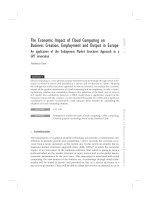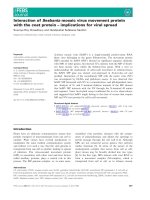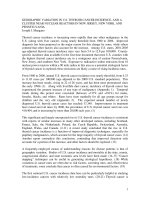The Economic Climb Out for U.S. Airlines: Global Competitiveness and Long Term Viability air transportation association (2011)
Bạn đang xem bản rút gọn của tài liệu. Xem và tải ngay bản đầy đủ của tài liệu tại đây (2.64 MB, 39 trang )
The Economic Climb-Out for U.S. Airlines:
Global Competitiveness and Long-Term Viability
ATA Office of Economics
January 29, 2011
www.airlines.org
The Air Transport Association of America, Inc.
2
Combination Services
AirTran Airways
Alaska Airlines
American Airlines
United Airlines*
Delta Air Lines
Hawaiian Airlines
JetBlue Airways
Southwest Airlines
US Airways
All-Cargo Services
ABX Air
ASTAR Air Cargo
Atlas Air Worldwide Holdings
Evergreen Int’l Airlines
FedEx Corporation
UPS Airlines
Associate Members
Air Canada
Air Jamaica
Air transport has become an essential economic and social conduit throughout the
world. Beyond the benefits of fast and inexpensive transcontinental travel, air
transport also has become a vital form of shipping for high-valued items that need
to come to market quickly…
— World Bank (www.worldbank.org/airtransport)
* Includes Continental Airlines
www.airlines.org
OVERVIEW
3
• Safety of commercial travel exceeds other modes and continues to improve
• DOT statutory mission explicitly recognizes importance of airline industry
viability and global competitiveness
• A viable, competitive U.S. airline industry is good for the country, fueling jobs and growth
• Numerous stakeholders benefit from a financially viable, competitive U.S. airline industry
• Competition among airlines remains intense
• Battlefield is increasingly global, with a relatively mature domestic market
• U.S. airlines are financially weaker than many non-U.S. airlines
• To reinvest in product/people, airlines need substantially improved finances
• Competing in the global marketplace is essential for airlines and good for USA
www.airlines.org
The State of the Industry
Fitch: ―2011 Outlook: U.S. Airline Balance Sheet Repair to Continue‖
4
―Fitch [Ratings] expects ratings for most U.S. airlines to improve in 2011, reflecting a
modest strengthening of industry operating fundamentals and steady progress toward
debt reduction and balance sheet deleveraging. As U.S. carriers look to unwind the
lingering effects of historically weak returns, insufficient cash flow generation, and
constrained liquidity, deployment of cash toward debt repayment will be essential if the
ratings momentum witnessed in 2010 is to continue for another year.‖*
Much like the U.S. economy, U.S. airlines are climbing out of a deep hole and have a long
way to go to be financially strong: (1) attain investment-grade credit and generate a
return on invested capital in excess of cost of capital through a full business cycle
U.S. airlines are focused on shoring up balance sheets to reinvest in product, people and
planes, and to weather the next fuel spike or economic downturn without significant
reductions in personnel or service; the global aviation marketplace, where traffic growth
is most promising, is increasingly relevant and intensely competitive
Restructuring has become a way of business – we’re in a period of continual reinvention
* Fitch Ratings, ―2011 Outlook: U.S. Airline Balance Sheet Repair to Continue‖ (Dec. 9, 2010)
www.airlines.org
U.S. Carriers: Competing in a Global Marketplace
5
USA
Non
-USA
Republic/Shuttle America
Air France/KLM
US Airways/America
West
Copa/
AeroRepública
SkyWest/Atlantic
Southeast
Lufthansa/Swiss
Lufthansa/JetBlue*
Air
China/Cathay Pacific*
Delta/Northwest
Cathay Pacific/
Dragonair
Republic/Midwest
Lufthansa/Brussels*/BMI/Austrian
Republic/Frontier
Avianca
/TACA
United/Continental
British Airways/Iberia
SkyWest
-ASA/ExpressJet
LAN/TAM
Southwest/AirTran
LAN/Aires*
Selected M&A and/or Cross-Border Investment: 1995-Present
Source: ATA and Deutsche Bank Global Research * Strategic investment but not full ownership or control
www.airlines.org
An Analyst/Investor View
Source: Deutsche Bank Global Research (Jan. 13, 2011)
―Consolidation, in our review, represents a later stage for a
mature industry that is seeking ways to address its financial
volatility… Our view is that consolidation is part of a longer-term
process that should ultimately allow the global airline industry
to efficiently allocate capital and assets such that a positive
return on invested capital can be achieved…
On the surface, airlines pursue mergers as a means to improve
profitability…and their competitive positioning via an expanded
network. Longer-term, consolidation should improve industry
viability while mitigating industry volatility and consequently
lower its cost of capital.‖
6
Source: ―Global Airline Sector – Laying the Foundation for Global M&A,‖ Deutsche Bank Global Research (Jan. 13, 2011)
www.airlines.org
Air Travel Safer Than Other Forms of Intercity Transport
U.S. Passenger Fatalities per 100 Million Passenger Miles, 1998-2007
7
Source: National Safety Council Injury Facts® 2010 Edition, 1998-2007 averages (most recent available)
1. Passenger cars/taxis; drivers considered passengers; data from the NSC Fatality Analysis Reporting System
2. Does not include school buses; data from the NSC Fatality Analysis Reporting System
3. Data from the Federal Railroad Administration (FRA)
4. Large and commuter airlines, excluding cargo; data from the National Transportation Safety Board (NTSB)
0.75
0.04 0.04
0.01
Auto (1) Bus (2) Rail (3) Airline (4)
www.airlines.org
Each Decade, U.S. Airline Safety Has Improved Markedly
Fatal Accidents per Million Aircraft Departures in Scheduled Service
8
0.8810
0.5050
0.2919
0.1230
1970-79 1980-89 1990-99 2000-09
Source: ATA analysis of data from the National Transportation Safety Board
www.airlines.org
DOT Statutory Mission Explicitly Recognizes Importance of
(and Role in) Industry Viability and Competitiveness
U.S. Code, Title 49, Sec. 40101. Policy, Subsection A: ―Economic Regulation‖
(6) placing maximum reliance on competitive market forces and on actual and
potential competition — (A) to provide the needed air transportation system; and (B)
to encourage efficient and well-managed air carriers to earn adequate profits and
attract capital, considering any material differences between interstate air
transportation and foreign air transportation.
(14) promoting, encouraging, and developing civil aeronautics and a viable, privately-
owned United States air transport industry.
(15) strengthening the competitive position of air carriers to at least ensure equality
with foreign air carriers, including the attainment of the opportunity for air carriers to
maintain and increase their profitability in foreign air transportation.
(16) ensuring that consumers in all regions of the United States, including those in
small communities and rural and remote areas, have access to affordable, regularly
scheduled air service.
9
www.airlines.org
A Viable, Competitive U.S. Airline Industry Is Good for The
Country, Fueling Jobs and Economic Growth
10
“Aviation is the glue that keeps the global economy together. Without widely accessible and
well-priced air travel, the global economy will quickly become less global.”
— Dr. Mark Zandi, Chief Economist & Co-Founder, Moody‟s Economy.com (August 2008)
$1.225 trillion/year in economic activity
$371 billion/year in personal earnings
10.9 million jobs
―The Economic Impact of Civil Aviation on the
U.S. Economy‖ (FAA, Dec. 2009)
Commercial aviation helps drive:
Commercial aviation contributes:
$731.5 billion/year to U.S. GDP
5.2% of U.S. GDP
“Economic growth and prosperity are determined
in large part by access to the global economy.
And, just as islands require bridges to the
mainland….communities require bridges to the
global economy. Air transportation is that bridge,
providing the necessary access for U.S. cities…to
enjoy a „Virtuous Circle of Economic Growth.‟”
“The Plane Truth About Air Service and Economic Development,”
Global Aviation Improvement Network, Booz Allen (March 2001)
“Every day, the airline industry propels the economic takeoff of our nation. It is the great
enabler, knitting together all corners of the country, facilitating the movement of people and
goods that is the backbone of economic growth. It also firmly embeds us in that awesome
process of globalization that is defining the 21st century.”
— Daniel Yergin, Author, Commanding Heights: The Battle for the World Economy, in the ATA 2005 Economic Report
www.airlines.org
Commercial Aviation Drives Nearly 11 Million U.S. Jobs
11
Air Transport
3.0
Airport
Operations
0.6
Aircraft
Manufacturing
1.1
Visitor
Expenditures
5.9
Travel
Arrangements
0.2
U.S. Job Impact by Aviation Activity, In Millions
Source: Federal Aviation Administration, “The Economic Impact of Civil Aviation on the U.S. Economy,” (December 2009)
www.airlines.org
Numerous and Varied Stakeholders Benefit From a
Financially Viable, Competitive U.S. Airline Industry
Service Continuity, Job Security, Reinvestment in Product and People
Airline/Airport/Aerospace Workers
Hub Cities
Spoke Communities
U.S. Treasury
Small Businesses
Corporate America
Aviation Suppliers
National Defense
Air Travelers and Shippers
People Who’ve Never Flown
Agriculture Interests
Manufacturing Sector
Importers/Exporters
Travel and Tourism
Humanitarian/Relief Workers
Medical/Emergency Personnel
12
www.airlines.org
Inter-Airline Competition Remains Intense
13
―The purpose of this study is to examine the competitiveness of the U.S.
domestic airline industry following a period of unprecedented financial turmoil
and considerable change in industry structure…. [T]he industry is more
competitive now than at any other time in the 12-year period examined.‖
―One area of promise for the network airlines is the prospect for continued
international expansion to provide support for their domestic networks.
Although the airlines (and consumers) have benefited from the international
network development enabled by the liberalization created by open skies
agreements, the potential for much greater progress is large.‖
— Former DOT officials Randy Bennett, Patrick Murphy and Jack Schmidt,
―A Competitive Analysis of An Industry in Transition‖ (July 2007)
www.airlines.org
Economic Forces Continue Toll on Airline Jobs*
U.S. Passenger Airline Full-Time Equivalent (FTE) Employees in Thousands*
14
461.9
430.3
446.8
442.0
426.8
433.1
442.4
454.8
478.1
509.0
530.9
499.3
476.4
431.7
440.6
413.6
403.4
417.9
394.2
379.7
378.1
Oct-90
Oct-91
Oct-92
Oct-93
Oct-94
Oct-95
Oct-96
Oct-97
Oct-98
Oct-99
Oct-00
Oct-01
Oct-02
Oct-03
Oct-04
Oct-05
Oct-06
Oct-07
Oct-08
Oct-09
Oct-10
* Full-time equivalent employees in thousands (see
All-Time Peak (May 2001) = 544.4
www.airlines.org
The Lost Decade: Industry Climbing Out of a Deep Hole
Net Income ($Billions) and Profit Margin (%) for U.S. Airlines*
15
$0.6
$1.6
$3.6
($1.5)
$16.3
($53.7)
1951-1960 1961-1970 1971-1980 1981-1990 1991-2000 2001-2010E
(0.3%)
(~4%)
* All U.S. passenger airlines and cargo airlines reporting to DOT Form 41 P-12, Accounts 9899 and 4999
3.2% 1.9% 2.7% 1.6%
www.airlines.org
A Quarter or Two of Profit Will Not Suffice
Meaningful Profitability Needed to Reinvest, Compete Abroad
-35%
-30%
-25%
-20%
-15%
-10%
-5%
0%
5%
10%
1Q08
2Q08
3Q08
4Q08
1Q09
2Q09
3Q09
4Q09
1Q10
2Q10
3Q10
4Q10
Source: ATA analysis of DOT Form 41 reports
EBITDAR* Profit Margins: U.S. Passenger Airlines
16
* Earnings before interest, taxes, depreciation, amortization and rents; an approximate measure of a company’s operating cash flow based on data from the company’s income
statement. Rent is included in the measure to evaluate the financial performance of airlines and other companies (e.g., casinos, restaurants) that have significant rental and
lease expenses derived from business operations.
www.airlines.org
Doing Better and Doing Well Are Not the Same Thing
17
3
4
5
6
7
8
9
10
11
1980
1983
1986
1989
1992
1995
1998
2001
2004
2007
2010
Sources: Bureau of Labor Statistics ( and Bureau of Economic Analysis (
U.S. Unemployment Rate (9.4%)
Percent
$12.5
$12.6
$12.7
$12.8
$12.9
$13.0
$13.1
$13.2
$13.3
$13.4
$13.5
1Q05
1Q06
1Q07
1Q08
1Q09
1Q10
Real U.S. GDP
Trillions of Chained 2005 Dollars, SAAR
www.airlines.org
DOT Airline Customer Service Metrics
18
2000 2007 2008 2009 1Q-3Q10
Flight Cancellations
(as % of sched. domestic departures)
3.30 2.16 1.96 1.39 1.75
Taxi-Out* Times > Three Hours
(per 10,000 domestic departures)
2.92 2.22 1.76 1.40** 0.25**
On-Time Arrival Rate
(% of domestic flights within 00:15)
72.6 73.4 76.0 79.5 79.8
Involuntary Denied Boardings
(per 10,000 passengers)
1.04 1.12 1.11 1.19 1.19
Mishandled Bags
(per 1,000 domestic passengers)
5.29 7.05 5.26 3.91 3.59
Customer Complaints
(per 100,000 systemwide passengers)
2.98 1.38 1.13 0.97 1.30
* Time elapsed between departure from the origin airport gate and wheels off
Sources: Bureau of Transportation Statistics and DOT Air Travel Consumer Report (
** Effective October 2008, BTS monthly reports on tarmac times included, for the first time, data from flights which were subsequently cancelled, diverted,
and/or had multiple gate departures (see
www.airlines.org
Breakeven Load Factor Finally Below 80% Again
Yields (Fares per Mile) Closing Gap to Unit Costs of Operation
19
65%
70%
75%
80%
85%
90%
2000
2001
2002
2003
2004
2005
2006
2007
2008
2009
2010
2011
2012
Source: ATA Passenger Airline Cost Index
Four-Quarter
Moving Average
www.airlines.org
Average U.S. Price per Gallon of Jet Fuel
$0.59
$1.05
$2.20
$2.61
$2.72
1991-2000 2001-2005 2006-2010 2011 (EIA-F) 2012 (EIA-F)
Airline Energy Costs Are High and Poised to Rise
Source: Energy Information Administration, including Short-Term Energy Outlook (Jan. 11, 2011) forecast of ―Jet Fuel Refiner Price to End Users
20
www.airlines.org
Crack Spread (Refining Margin) Back to $20-$25/bbl Territory
Jet Fuel Prices: Not Just a Crude Story
Source: ATA and Energy Information Administration
21
$60
$70
$80
$90
$100
$110
$120
4-Jan-10
18-Feb-10
4-Apr-10
19-May-10
3-Jul-10
17-Aug-10
1-Oct-10
15-Nov-10
30-Dec-10
13-Feb-11
30-Mar-11
Crack Spread
Jet Fuel (Gulf Coast)
Crude Oil (WTI)
www.airlines.org
For U.S. Passenger and Cargo-Only Airlines, Fuel
Expenditures Trending Up Despite Lower Consumption
22
Sources: ATA, Energy Information Administration, Department of Transportation
Note: Value in parentheses below year is average price paid per gallon excluding taxes, into-plane fees, pipeline tariffs and hedging costs; YE = year ended
16.8
15.0
12.8
15.5
22.7
33.2
38.8
41.9
57.8
32.3
37.4
16
17
18
19
20
21
$10
$20
$30
$40
$50
$60
2000
($0.82)
2001
($0.78)
2002
($0.72)
2003
($0.85)
2004
($1.16)
2005
($1.66)
2006
($1.97)
2007
($2.11)
2008
($3.07)
2009
($1.90)
YE 9/10
($2.19)
Billion Gallons
Billion Dollars
www.airlines.org
Tax Bite on a $300 One-Stop Round Trip*
Growing Governmental Take Leaves Less Revenue for Carriers
23
Source: ATA analysis of federal tax code
* Sample itinerary assumes one-stop domestic round trip with maximum passenger facility charge (PFC) per airport; $300 total price includes taxes and fees.
2011 Taxes
20% ($61)*
1972 Taxes
7% ($22)*
1992 Taxes
13% ($38)*
TAX
AIRFARE
www.airlines.org
“Special” Aviation Tax Burden* Exceeded $16B in 2010
In Addition to Typical Federal/State/Local Corporate Taxes (e.g., Income, Property)
24
$2,787
$1,808
$282
$599
$291
$460
$7,261
$2,324
$395
$351
$16,558
* Federally levied/approved commercial aviation taxes/fees only; some taxes/fees shown include collections from non-U.S. carriers; PFCs reflect FAA estimate as of Nov. 2010
Sources: Department of Homeland Security, FAA, Office of Management Budget, Transportation Security Administration, ATA
DHS = $3.4B
FAA = $10.3B
2010 collections ($millions) from airlines
Federal Aviation Administration (FAA)
Department of Homeland Security (DHS)
U.S. Airports
www.airlines.org
Demand for Domestic Air Travel Has Not Recovered
Domestic Passenger Revenue (¢) per $100 of U.S. Gross Domestic Product
25
45
50
55
60
65
70
75
1991-2000
2001
2002
2003
2004
2005
2006
2007
2008
2009
2010E
Source: ATA analysis of BEA and BTS data
Shortfall = $34B









